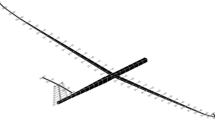Abstract
To accelerate the design phases of the antiskid control system for a turboprop aircraft and to effectively ensure appropriate results, a brake-by-wire antiskid control system for a business aircraft is designed and investigated using a new virtual prototy** technology, which significantly reduces time, effort and cost. In contrast to traditional empirical formula methods, a multidisciplinary modeling co-simulation method has been proposed in this paper. The mathematical modeling process and antiskid control algorithm (Pressure Bias Modulation–Proportional–Integral Derivative) were analyzed and adopted. The co-simulation model was designed based on multi-body dynamic and multidisciplinary approach. The simulation results were compared with measured data sampled from an inertial platform test rig. The simulation results and physical experiment results proved the efficiency of the overall system.











Similar content being viewed by others
Data availability statement
The data that support the findings of this study are available on request from the corresponding author, upon reasonable request.
References
Moir I, Seabridge A (2008) Aircraft systems: mechanical, electrical and avionics subsystems integration. Wiley, Chichester
SAE International (2016) AIR 1739B, information on antiskid systems. https://doi.org/10.4271/AIR1739B
D’Avico L, Tanelli M, Savaresi SM, Airoldi M, Rapicano G (2017) A deceleration-based algorithm for anti-skid control of aircraft. IFAC-Papers OnLine 50(1):14168–14173
D'Avico L, Tanelli M, Savaresi SM (2018) Experimental validation of landing-gear dynamics for anti-skid control design. In: 2018 European control conference (ECC), pp 2751–2756. https://doi.org/10.23919/ECC.2018.8550258
O`Callaghan, John J (2016) Slippery when wet: the case for more conservative wet runway braking coefficient models. In: 16th AIAA Aviation Technology, Integration, and Operations Conference, 2016
Moir I, Seabridge A (2012) Design and development of aircraft systems. Wiley, Chichester
Tunay I, Amin M, Rodin E (1999) Neural network augmented anti-skid controller for transport aircraft. In: Paper presented at 37th aerospace sciences meeting and exhibit, Reno, USA
Klein-Paste A (2018) Airplane braking friction on dry snow, wet snow or slush contaminated runways. Cold Regions Sci Technol 150:70–74. https://doi.org/10.1016/j.coldregions
Bakker E, Nyborg L, Pacejka H (1987) Tyre modelling for use in vehicle dynamics studies. SAE Paper No. 870421
Bates D, Hagström M (2007) Nonlinear analysis and synthesis techniques for aircraft control. Springer, Berlin
Mei-Ying Z, Li-Li X (2005) Research on digital simulation of aircraft hydraulic braking system. Comput Simul 22(8):45–49
Ming Z, Hong N, **ao-Hui W, Enzhi Z (2008) Research on modelling and simulation for aircraft anti-skid braking. In: 2008 2nd International symposium on systems and control in aerospace and astronautics, pp 1–5. https://doi.org/10.1109/ISSCAA.2008.4776394
Vasiliu N, Vasiliu D, Călinoiu C, Puhalschi R (2018) Simulation of fluid power systems with Simcenter Amesim. Taylor & Francis, CRC Press, Boca Raton
Yin Q, Hong N, Wei X, Li J (2017) Modeling and simulation of high-speed aircraft direction rectification using co-simulation method. In: AIAA modeling and simulation technologies conference. https://doi.org/10.2514/6.2017-3829
Neto MM, Góes LCS (2017) Use of LMS amesim model to predict behavior impacts of typical failures in an aircraft hydraulic brake system. In: Proceedings of 15th Scandinavian international conference on fluid power, June 7–9, 2017, Linkö**, Sweden. Linkö** electronic conference proceedings, vol 144, issue 3, pp 29–43
Pang B, Wu S, Zhao X, Jiao Z, Yang T (2018) A hardware-in-the-loop simulation for aircraft braking system. In: CSAA/IET international conference on aircraft utility systems (AUS 2018), pp 1538–1543. https://doi.org/10.1049/cp.2018.0123
Author information
Authors and Affiliations
Corresponding author
Ethics declarations
Conflict of Interest
The authors declare that they have no known competing financial interests or personal relationships that could have appeared to influence the work reported in this paper.
Additional information
Publisher's Note
Springer Nature remains neutral with regard to jurisdictional claims in published maps and institutional affiliations.
Rights and permissions
Springer Nature or its licensor (e.g. a society or other partner) holds exclusive rights to this article under a publishing agreement with the author(s) or other rightsholder(s); author self-archiving of the accepted manuscript version of this article is solely governed by the terms of such publishing agreement and applicable law.
About this article
Cite this article
Li, D., Lin, M. & Zhang, T. Design and Co-simulation of an Antiskid Brake System for a Civil Aircraft. Int. J. Aeronaut. Space Sci. 24, 845–852 (2023). https://doi.org/10.1007/s42405-022-00555-3
Received:
Revised:
Accepted:
Published:
Issue Date:
DOI: https://doi.org/10.1007/s42405-022-00555-3




